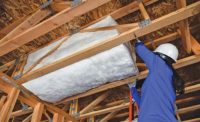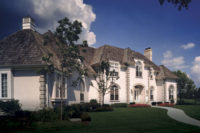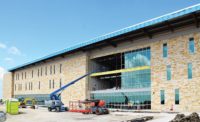Continuous insulation has established itself as the industry standard for achieving optimum building performance. And in most regions, CI is raising the bar on energy efficiency and high-performance solutions for buildings.
As building codes and requirements continue to trend toward greater attention to higher efficiency requirements, contractors are recognizing how insulation plays into the wall performance of a building. To better explain how CI enhances the energy efficiency of wall systems, here is the why, what, where, and when.
Why: Using CI to Increase Energy Efficiency in Wall Systems
As defined by the U.S. Department of Energy and model building codes, “continuous insulation” is insulation that runs continuously over structural members and is free of significant thermal bridging. It is installed on the interior or exterior, and is integral to any opaque surface of the building envelope.
Although CI can serve a number of different roles when incorporated into a building structure, most importantly, it eliminates or greatly reduces the existence of thermal bridges. Thermal bridging occurs when a poorly insulating material allows an easy pathway for heat flow across the thermal envelope. Thermal bridging in buildings can reduce energy efficiency, create indoor heating and/or cooling problems, and even lead to condensation issues. Therefore, reducing the risk of thermal bridging not only cuts down on energy costs, but also can reduce condensation that could cause mold, rot, and rust, and harm indoor air quality.
The most common thermal bridges, and what are addressed by most codes, are thermal bridging through framing. Although steel is the most obvious offender, wood framing can also hurt wall thermal performance. For example, in a typical framed wall, framing can easily account for 25 percent or more of the wall area allowing heat to easily flow through the structure and reduce energy efficiency.
Other structures, such as balconies, slab edges, awnings or porte-cochères, have elements that can also contribute to thermal bridging. These can be effective in taking the heat out of a building and ejecting it into the surrounding air, resulting in high heating costs and cold floors.
Other benefits of CI? Certain CI materials can also act as air barriers and water-resistive barriers when integrated with window and door details. Other materials can satisfy structural, green building, or fire requirements, while also addressing practical needs such as cladding installation.
What: The Right Product Mix for Optimal Wall Performance
Determining the proper amount and type of continuous insulation to use for a given project might seem challenging, especially when considering how the overall insulation and air barrier system can help manage condensation and heat transfer.
When selecting the product that will best achieve your CI goals, thickness is often a critical consideration. As CI materials get thicker (to meet code requirements), this can lead to other issues in the project, including fastener length, cladding attachments, and integration with flashings, and door and window jambs. Therefore, identify the product that meets the building requirements at a minimum thickness. One popular concept is to incorporate foam plastic insulating sheathing (FPIS), a widely used and cost-effective product, into the wall assembly.
Due to its high thermal performance, polyisocyanurate foam (polyiso) is the product of choice for energy-aware contractors, building owners and homebuilders. With one of the highest R-values of 6 per inch, polyiso foam is an excellent choice for achieving thermal efficiency. It has a low tendency to absorb moisture, is solvent-resistant, and provides strong dimensional stability and fire performance. When seams are taped, penetrations sealed, and the system is integrated with window and door flashings, polyiso foam sheathing can also create an effective air barrier and water-resistive barrier, eliminating the need for a separate building wrap.
Another effective CI option is to install closed-cell spray polyurethane foam (ccSPF) on the exterior of the building envelope. When integrated with window and door flashings, exterior ccSPF can provide continuous insulation, air barrier, water-resistive barrier, and vapor retarder functions in one installation step.
Once the type of CI product is determined, it is important to consider the other insulation, air-sealing, and moisture management strategies that will be implemented. Products like fiber glass, mineral wool, and spray foam work together with CI to ensure long-term energy efficiency. Combined with a proper installation, the right mix of products will determine whether or not the structure will deliver a durable and long-lasting performance.
Where: The Impact of Location and Climate on Wall Performance
Installing the right mix of insulation products in the building depends on where and how in the structure CI will be installed, what R-values are required and the climate the project is in.
Understanding which energy efficiency and building codes and standards are in place is crucial in determining how to achieve CI in the project. For the current status of energy codes and standards adoptions by state, visit energycodes.gov or iccsafe.org.
CI will have the biggest impact when applied to the entire building structure, eliminating thermal bridging through the roof, walls, and foundation.
Consider installing CI throughout the structure to provide heat, moisture, and air control, protect the building’s exterior and increase energy efficiency.
When: Collaborating with Teams to Incorporate CI
Collaborate with project partners early on in the construction process to agree on the best overall insulation, air-sealing, and moisture management strategy, including CI. This will help the team avoid costly oversights or decreased building efficiency.
Learn early on about the planned designs, and recommend improvements to the wall assembly and the right product mix for the project. Once a design is finalized, be sure to communicate what other trades (such as framers or window installers) need to do to help ensure a successful CI installation later on.
As building codes move toward higher energy efficiency, CI can play a crucial role in meeting or exceeding energy code R-values or U-factors, when used in conjunction with traditional insulation methods.
Although CI is seen as an affordable or economical option for contractors, the benefits of a proper building envelope go beyond project savings. As the boundary between the interior and exterior, the building envelope provides outdoor protection and indoor comfort, adding value to the building, and saving the future owner money.
Continuous insulation has become a mainstream concept that should be considered when determining a cost-effective and long-term solution for eliminating thermal bridges and maximizing a building’s energy efficiency and performance.










Report Abusive Comment